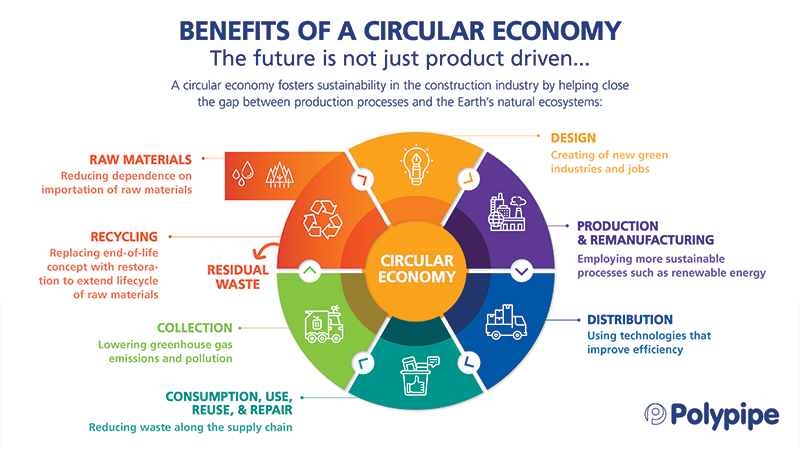5 Reasons why we should move towards a circular economy
Thursday 25th February 2021

Our cities today are the centre of economic and industrial growth. They contribute to about 60% of global GDP, however, they also account for an estimated 70% of global carbon emissions and over 60% of resource use, within which the construction industry alone accounts for 38% of total CO2 emissions.
With over half of the world’s population residing in cities, the impact of the recent pandemic has only intensified the effects of rapid urbanization, leading to increased pressure on infrastructure and key services such as waste collection and water sanitation.
That is why the UN conceived Goal 11 in their Sustainable Development Goals. In an attempt to “achieve a better and more sustainable future for all”, the organisation outlined 17 interlinked global goals to be achieved by 2030. Goal 11 seeks to make cities and human settlements inclusive, safe, resilient and sustainable.[i]
To achieve true sustainable development, however, disruptive change is required in the way the global construction industry operates.
And this is where a circular economy model can really make a difference…
Eliminating waste through a circular economy model
According to the World Economic Forum, a circular economy is a model that is restorative and regenerative by intention and design. Essentially, the idea is to replace the end-of-life concept for materials and products, with restoration.[ii]
A circular economy seeks to eliminate waste through superior design of materials, products, systems and business models. This is made possible by shifting towards more sustainable practices throughout the supply chain in the construction industry.
In a traditional, linear economy model, raw natural resources are collected, manufactured into products and then disposed of, mostly in landfill sites, at the end of their life cycle,
In contrast, a circular economy functions in a way that closes the gap between production processes and the earth’s natural ecosystem cycles.

Designed to last
A circular economy is centered around three basic principles:
- Design out waste and pollution
- Keep products and materials in use
- Regenerate natural systems
The model is actually based on the idea that there is no such thing as waste. Products are designed to last, produced using high-quality, recyclable materials and optimized for disassembly and reuse, facilitating the process of renewal at the end of their life cycle.
Aside from disposal and recycling, a circular economy also addresses the embedded consequences of energy and labour in our production cycles. A circular model aims to preserve natural resources by reducing demand for them through reuse.
Redefining growth - Benefits for the construction industry
As a model that is inherently regenerative, it is capable of improving how the industry consumes the earth’s natural resources and ultimately, preventing the negative consequences that climate change can cause for our businesses.
Its benefits can deliver a significant potential for value creation in the industry:
1. Reduce Greenhouse Gas Emissions
A circular economy uses renewable energy resulting in less pollution caused by fossil fuels. Furthermore, the preferred choice for manufacturing processes would be energy-efficient equipment and non-toxic materials, all which would decrease emissions of greenhouse gases.
2. Material Cost Saving
Due to reuse and dematerialization in the circular economy model, fewer materials and productions processes are actually needed to deliver functional products. This not only mitigates supply chain risk but could lead to potential cost saving of up to USD 700 billion globally.[iii]
3. Increased innovation
The process of replacing linear products and systems with circular ones is a creative opportunity that will encourage higher rates of technological development, leading to innovations across material manufacturing, energy production and labour.
4. Creation of new green industries and jobs
A circular economy emphasizes creating local material loops and shortening supply chains. Furthermore, labour-intensive recycling activities, high-skill remanufacturing, renewable energy and technological development can all present new employment opportunities.
5. Economic Growth
Lower costs of production, coupled with new revenue streams emerging from circular activities, affects economy-wide supply, demand and prices. The ripple effect across sectors can lead to overall economic growth.

A circular economy looks beyond our current industrial model to redefine growth and focus on positive benefits. The construction industry plays a key role in the creation of a circular economy.
The future of the construction industry is not just product driven. By adopting practices that support a circular economy, benefits are delivered to every part of the supply chain and consequently to the end user and to society as a whole. In the GCC, we can foster increased sustainability by altering national policies to promote it, potentially unlocking more than $2 trillion in economic growth and create more than 1 million jobs by 2030.[iv]
Contact us today to discuss how these sustainable practices can be usable to you and be applied to your next project.
Tel: +971 (0) 4 518 3000
Email: middleeast@polypipe.com
[i] https://sdgs.un.org/goals
[ii] https://reports.weforum.org/toward-the-circular-economy-accelerating-the-scale-up-across-global-supply-chains/from-linear-to-circular-accelerating-a-proven-concept/
[iii] https://www.ellenmacarthurfoundation.org/explore/the-circular-economy-in-detail
[iv] https://www.strategyand.pwc.com/m1/en/articles/2020/the-business-case-for-environmental-sustainability-in-the-gcc.html
https://youmatter.world/en/definition/definitions-circular-economy-meaning-definition-benefits-barriers/
